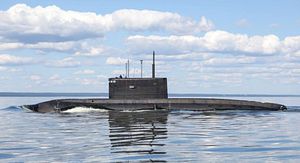Russia’s Pacific Fleet will receive six new Project 636.3 Kilo-class (aka Vashavyanka-class) diesel-electric attack submarines by 2021 under a September 7 contract signed between the Russian Ministry of Defense and two state-owned Russian ship makers — St. Petersburg-based Admiralty Shipyard and Armur Shipbuilding Plant, located in Russia’s Far East — according to local media reports.
“The term of delivery of the six boats [is] two in 2019, two in 2020 and two in 2021,” the head of Admiralty Shipyard, Alexander Buzakov told TASS news agency on September 7. Russia’s Minister of Defense Sergei Shoigu confirmed in August that six new Project 636.3 Kilo-class subs will be built specifically for service in the Pacific Fleet (See: “Russia to Receive 12 New Warships in 2016”).
The six new additional diesel-electric attack submarines will be a major boost for Russian naval power in the Asia-Pacific region. In 2015, for the first time since the collapse of the Soviet Union, the Pacific Fleet also received a new Project 955 Borei-class (“North Wind”) aka Dolgorukiy-class nuclear-powered ballistic missile submarine (SSBN). A second Borei-class SSBN is slated to join the fleet by the end of the year.
The decision to build six Project 636.3 Kilo-class submarines for the Russian Navy is partially caused by repeated delays in the Project 677 Lada-class diesel-electric attack submarine program. The Russian Navy initially wanted to operate the first three Lada-class subs by 2018. As of now, however, only the lead ship of the class has been commissioned and is currently undergoing sea and weapons trials. The other two vessels are expected to be commissioned by 2019.
The Project 636.3 Kilo-class is an improved variant of the original Project 877 Kilo-class design. The updated version is slightly longer in length — the sub’s submerged displacement is around 4,000 tons — and feature improved engines, an improved combat system, as well as new noise reduction technology. The submarine has a crew of around 50 and can conduct patrols for up to 45 days. The improved Kilo-class can fire both torpedoes and cruise missiles, launched from one of six 533 millimeter torpedo tubes.
The submarine has primarily been designed for anti-submarine and anti-surface ship warfare. However, it can also attack land targets. In December 2015, a Project 636.3 Kilo-class sub fired four M-54 Kalibr (NATO designation: SS-N-27A “Sizzler”) cruise missiles against targets around and near Raqqah in Syria. “The 3M-54 Kalibr is a supersonic cruise missile available in land-attack, anti-ship, and anti-submarine variants. It is specifically designed to evade active air defenses and electronic countermeasures,” I explained elsewhere.































